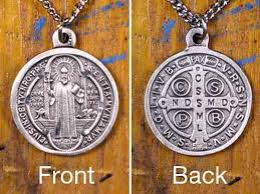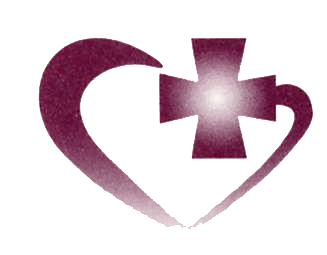
ORIGIN OF THE MEDAL
St. Benedict, the founder of the famous Benedictine Order, which has given to the Church more than thirty popes and over fifty thousand saints, was born at Nursia in Italy in the year 430 and died at Monte Cassino in the year 548. This great saint had a profound veneration for the Holy Cross of our Savior and performed many miracles by its means. He taught his followers to have great reverence for the sign of our redemption and to rely on its use in combating the three-fold enemy of our salvation—the world, the flesh and the devil. Maurus and Placid, his first two disciples, for instance, wrought many miracles through the power of the cross. Thus it happened that the name of St. Benedict came to be intimately associated with the cross of Christ and in the course of time a medal was struck in his honor.EXPLANATION OF THE MEDAL
Front of Medal
The front side of the medal represents St. Benedict holding a cross in one hand and his Holy Rule in the other. In small lettering on either side of the figure of St. Benedict are the words:Crux S. Patris BenedictiUnder the feet of St. Benedict are the words:
The Cross of the Holy Father Benedict
Ex S.M.Cassino, MDCCCLXXX
From the Holy Mount of Cassino, 1880
Special jubilee blessing of the medal was granted by the Pope on the fourteen hundredth anniversary of the birth of St. Benedict. Around the margin of the medal is inscribed:
Ejus in obitu nostro presentia muniamur
May His presence protect us in the hour of death.
St. Benedict has ever been considered the patron of the dying because of the circumstances attending his own happy death. He breathed forth his soul while standing in prayer before the Most Blessed Sacrament.
Reverse Side of Medal
The reverse side of the medal bears a cross, the sign of our redemption.On the upright bar of the cross are found the letters:
C.S.S.M.L.and on the horizontal bar of the cross:
N.D.S.M.D.These are the initial letters of the words:
Crux Sacra Sit Mihi Lux, Non Draco Sit Mihi Dux.
May the sacred Cross be my light, Let not the devil be my guide.
The four large letters in the arms of the cross
C.S.P.B.stand for:
Crux Sancti Patris Benedicti
The Cross of the Holy Father Benedict
At the top of the cross is the word Pax meaning Peace, expressing the purpose and final fruit of the Benedictine way of life.
Around the margin beginning at the upper right hand, we find the following letters:
V.R.S.N.S.M.V: S.M.Q.L.I.V.B.These are the initial letters of the words:
Vade Retro Satana;
Nunquam Suade Mihi Vana.
Sunt Mala Quae Libas;
Ipse Venena Bibas.
Get thee behind me, Satan;
suggest not vain thoughts to me.
evil is the cup thou offered;
drink thine own poison.
ST. BENEDICT’S INTERCESSION The life of St. Benedict was characterized by a powerful and all embracing love for God. His serene and unwavering dedication to a life based on prayer attests to his absolute trust in the providence of God. Through prayer, he opened himself up to the workings of the grace of God, and through that grace, God was pleased to use St. Benedict as his instrument of compassionate concern for those persons in need. The medal of St. Benedict acts as a reminder to its wearer of those virtues that the saint practiced during his life. The medal is an outward and concrete sign of the person’s interior commitment to a life marked by a constant prayerful disposition, trust in God and a life of charity. The tradition of the use of the medal of St. Benedict also is expressive of the Christian’s belief that St. Benedict’s active and effective concern for the Church on earth did not cease with his death, but continues today by his prayerful intercession for those who wear the medal.
USE OF THE MEDAL The practice of carrying on one’s person a blessed medal of St. Benedict has nothing in common with the pagan practice of amulets or good luck charms. The graces and favors bestowed are the fruit of faith in Christ Crucified, of the powerful intercession of St. Benedict and of the blessings which Holy Church gives to the medal and to those who wear it. The carrying of the medal is in itself an unspoken prayer, a plea for heavenly protection from all harm and a loving token of our attachment to God.
The medal may be worn about the neck, attached to one’s rosary or carried in purse or pocket. No special prayers are prescribed but the one who carries the medal should cherish a very special devotion to Christ Crucified and offer up daily all his thoughts, words and actions in union with the suffering Savior. He should also have great confidence in St. Benedict and ask that glorious saint of God frequently to be his special patron and protector at the throne of God’s mercy above.
Copies of this descriptive and explanatory leaflet of the medal of St. Benedict may be obtained from the:
BENEDICTINE MONKS
St. Benedict’s Abbey
Benet Lake, Wisconsin 53102
PRAYER FROM MASS OF ST. BENEDICT
God our Father, you made St. Benedict an outstanding guide to teach us how to live in your service. Grant that by preferring your love to everything else, we may walk in the way of your commandments.
Reprinted with permission from the: Benedictine Monks, St. Benedict’s Abbey, Benet Lake, Wisconsin 53102
